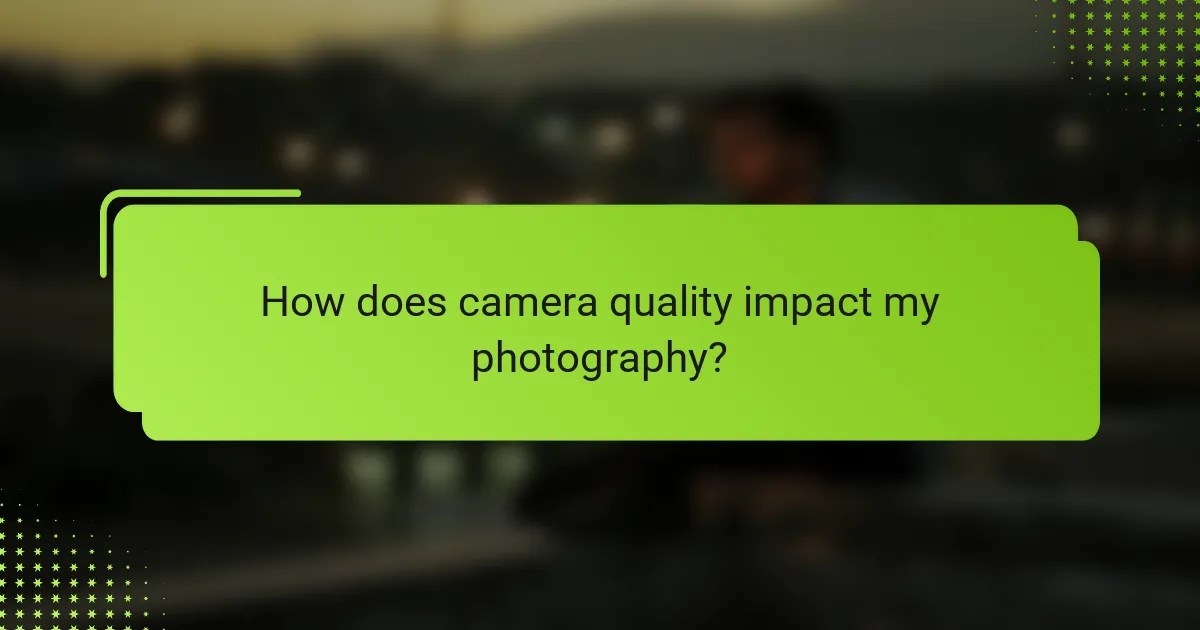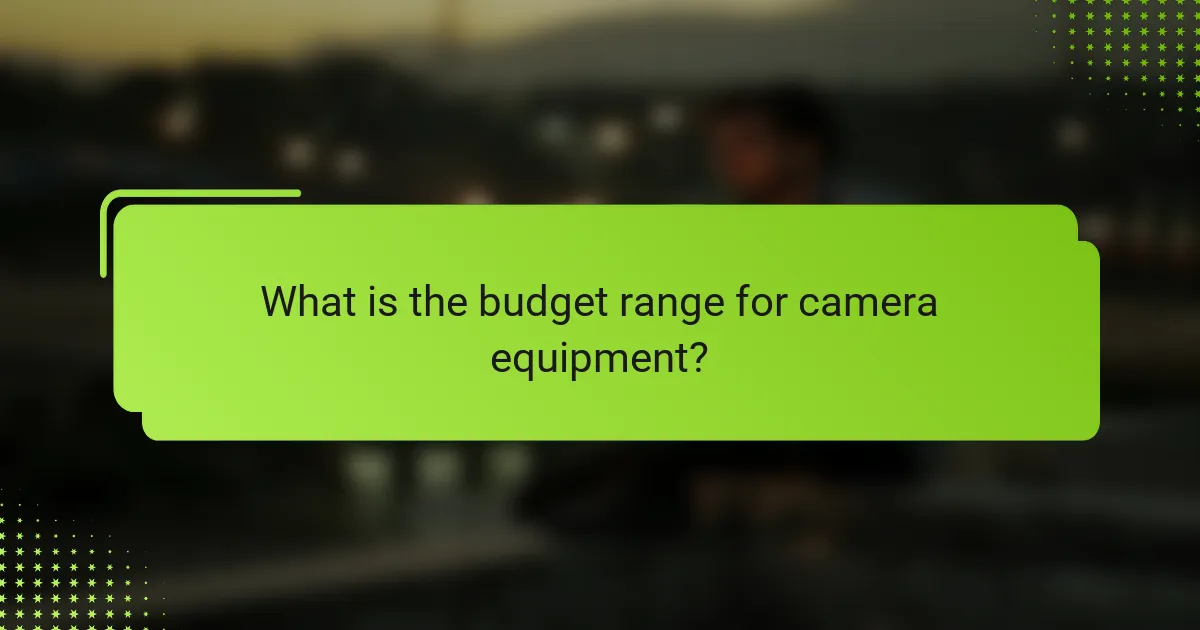Selecting the right camera equipment is crucial for achieving your desired photographic results and should align with your specific needs, preferences, and budget. Quality plays a significant role in the outcome of your images, with higher-end cameras offering better performance in diverse lighting conditions. Additionally, understanding your budget is essential, as options can range from affordable entry-level models to more expensive professional setups.

What camera equipment should I choose for my needs?
Selecting the right camera equipment depends on your specific needs, preferences, and budget. Consider factors such as versatility, portability, simplicity, and the type of photography you plan to pursue.
DSLR cameras for versatility
DSLR cameras are known for their versatility, offering interchangeable lenses and advanced features suitable for various photography styles. They typically provide superior image quality, manual controls, and excellent performance in low light conditions.
When choosing a DSLR, consider the sensor size, which can range from APS-C to full-frame, affecting image quality and depth of field. Brands like Canon and Nikon offer a wide selection of models, often starting around $500 for entry-level options.
Mirrorless cameras for portability
Mirrorless cameras are compact and lightweight, making them ideal for travel and everyday use. They also feature interchangeable lenses and often have faster autofocus systems compared to DSLRs.
While mirrorless options can be slightly more expensive, starting around $600, they provide excellent video capabilities and high-resolution sensors. Popular brands include Sony and Fujifilm, which cater to both amateur and professional photographers.
Point-and-shoot cameras for simplicity
Point-and-shoot cameras are designed for ease of use, making them perfect for casual photographers. They typically have fixed lenses and automatic settings, allowing users to capture images without extensive technical knowledge.
These cameras are generally affordable, with prices ranging from $100 to $500. Look for models with good optical zoom and image stabilization features to enhance your shooting experience.
Action cameras for adventure
Action cameras are built for durability and portability, making them suitable for capturing high-energy activities like sports and outdoor adventures. They are often waterproof and shockproof, allowing for versatile shooting in challenging environments.
Popular models, such as those from GoPro, start around $300 and offer features like 4K video recording and wide-angle lenses. Consider battery life and mounting options when selecting an action camera to ensure it meets your adventure needs.
Smartphone cameras for convenience
Smartphone cameras have advanced significantly, offering impressive image quality and convenience for everyday photography. They are always accessible and often come equipped with various shooting modes and editing features.
While not a replacement for dedicated cameras, high-end smartphones can capture stunning images, with many models priced between $700 and $1,200. Look for features like multiple lenses and low-light performance to enhance your photography capabilities.

How does camera quality impact my photography?
Camera quality significantly influences the overall outcome of your photography. Higher quality cameras typically produce sharper images, better colors, and improved performance in various lighting conditions, allowing for more creative freedom and professional results.
Sensor size and image quality
The sensor size in a camera directly affects image quality. Larger sensors, such as full-frame sensors, capture more light and detail, resulting in clearer images with less noise. For instance, a full-frame sensor can provide better quality in low-light situations compared to an APS-C sensor.
When selecting a camera, consider the type of photography you plan to pursue. If you often shoot landscapes or portraits, a larger sensor can enhance your images significantly. However, smaller sensors can be more portable and cost-effective for casual photographers.
Lens quality and sharpness
Lens quality is crucial for achieving sharp images. High-quality lenses are designed with better optics, which reduces distortions and aberrations, ensuring that your photos are crisp and clear. Investing in a good lens can often yield better results than upgrading the camera body alone.
When evaluating lenses, look for features such as low dispersion glass and advanced coatings. These elements help enhance sharpness and contrast. A prime lens, for example, often provides superior sharpness compared to a zoom lens at the same focal length.
Low-light performance
Low-light performance is a vital aspect of camera quality, especially for night photography or indoor settings. Cameras with larger sensors and wider apertures tend to perform better in low-light conditions, producing images with less noise and more detail.
To improve low-light photography, consider using a lens with a wide maximum aperture (like f/1.8 or f/2.8) and a camera with good high ISO capabilities. This combination allows for faster shutter speeds and clearer images in dim environments.
Dynamic range and color accuracy
Dynamic range refers to a camera’s ability to capture details in both the brightest and darkest areas of an image. A camera with a high dynamic range can produce more nuanced images, preserving details in highlights and shadows.
Color accuracy is equally important, as it affects how true-to-life your images appear. Cameras that excel in dynamic range and color reproduction help ensure that your photographs reflect the scene as you experienced it. Look for cameras that are known for their color science, especially if you shoot landscapes or portraits where color fidelity is critical.

What is the budget range for camera equipment?
The budget for camera equipment can vary significantly based on the type and quality of the gear. Generally, you can find options ranging from under $500 for entry-level models to over $1500 for professional setups.
Entry-level cameras under $500
Entry-level cameras are ideal for beginners or casual photographers. These models typically include basic features and automatic settings, making them easy to use. Brands like Canon, Nikon, and Sony offer reliable options in this price range.
Common choices include compact point-and-shoot cameras and entry-level DSLRs or mirrorless systems. Expect to find decent image quality and essential functionalities, although advanced features like 4K video may be limited.
Mid-range cameras between $500 and $1500
Mid-range cameras provide a balance between quality and affordability, catering to enthusiasts and semi-professionals. In this range, you can find DSLRs and mirrorless cameras with improved sensors, better autofocus systems, and more manual controls.
Examples include models from Canon’s EOS series or Sony’s Alpha line. These cameras often support interchangeable lenses, allowing for greater versatility in photography styles. Investing in a mid-range camera can significantly enhance your creative capabilities.
Professional cameras over $1500
Professional cameras are designed for serious photographers and videographers who require high performance and advanced features. This category includes high-end DSLRs and mirrorless systems, often equipped with larger sensors, superior low-light performance, and extensive customization options.
Brands like Canon, Nikon, and Fujifilm offer models that excel in various conditions, including fast action and low-light environments. When choosing a professional camera, consider factors such as lens compatibility, durability, and available accessories to ensure it meets your specific needs.

What factors should I consider when selecting camera equipment?
When selecting camera equipment, consider your intended use, the style of photography you pursue, and the overall quality of the gear. These factors will guide your decisions on budget, brand, and compatibility with accessories.
Intended use and photography style
Your intended use and photography style are crucial in determining the type of camera equipment you need. For instance, if you are a landscape photographer, a camera with high resolution and dynamic range will be beneficial, while sports photographers may prioritize fast autofocus and burst shooting capabilities.
Consider whether you will be shooting in controlled environments or challenging conditions, such as low light or extreme weather. This will influence your choice of lenses, camera bodies, and additional gear like tripods or weatherproof cases.
Brand reputation and support
Brand reputation plays a significant role in the reliability and longevity of camera equipment. Established brands often provide better customer support, warranty options, and a wider range of accessories. Research user reviews and professional recommendations to gauge the performance of different brands.
Additionally, consider the availability of service centers and repair options in your area. Brands with a strong presence in your country, such as Canon or Nikon in the US, may offer more convenient support compared to lesser-known manufacturers.
Accessory compatibility
Accessory compatibility is essential for maximizing the functionality of your camera system. Ensure that lenses, flashes, and other accessories are compatible with your chosen camera body to avoid additional costs or limitations in your setup.
For example, if you invest in a specific lens mount, check the availability of lenses and accessories that fit that mount. This can save you money and time in the long run, as you won’t need to replace gear when upgrading your camera body.

How can I evaluate the best camera brands?
To evaluate the best camera brands, consider factors such as reliability, image quality, and user support. Research reviews, compare specifications, and assess your specific needs to find a brand that aligns with your photography goals.
Canon for reliability
Canon is widely recognized for its dependable camera systems, making it a favorite among both amateur and professional photographers. Their cameras often feature robust build quality and consistent performance, which is crucial for capturing high-quality images in various conditions.
When selecting a Canon camera, look for models that suit your photography style, whether it’s DSLRs for versatility or mirrorless options for portability. Popular models like the Canon EOS R series offer advanced features while maintaining user-friendly interfaces.
Nikon for image quality
Nikon is renowned for its exceptional image quality, particularly in terms of color accuracy and dynamic range. Their sensors are often praised for producing sharp, vibrant images, making them a top choice for landscape and portrait photographers.
To maximize image quality with Nikon cameras, consider investing in high-quality lenses that complement your body. Models such as the Nikon Z series provide excellent low-light performance and high-resolution capabilities, enhancing your overall photography experience.



